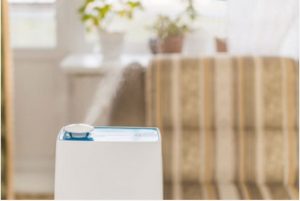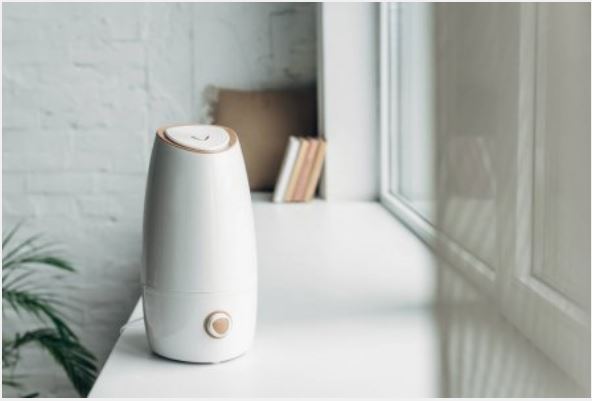The Pros and Cons of Using a Humidifier
 Humidifiers add moisture to your house or individual rooms to treat ailments such as dry skin, sinus congestion, coughing or bloody noses. It is especially useful for the winter months. Although it can help respiratory illnesses such as a cold or flu, using a humidifier incorrectly could potentially make them worse.
Humidifiers add moisture to your house or individual rooms to treat ailments such as dry skin, sinus congestion, coughing or bloody noses. It is especially useful for the winter months. Although it can help respiratory illnesses such as a cold or flu, using a humidifier incorrectly could potentially make them worse.
In this article, we will help you avoid these pitfalls by outlining the types of humidifiers, the correct size for your living space, the best placement, and how frequently you should clean your humidifier.
Evaporators
This humidifier, also known as a wick humidifier, emits moisture from a filter that is saturated in water. They are not as expensive as central humidifiers, but they only work in one room. The major downside to this type of humidifier is that it is prone to over-moisturizing the air, which could lead to mold and increased problems for asthma people. The wick filter in this model needs to be changed every three months.
back to menu ↑
Central humidifiers
These are the most expensive kind of humidifier, but they add moisture to the entire house. They are also safer, as central humidifiers do not emit steam, so they do not come with a risk of burns like traditional humidifiers. They have two primary styles: drum and flow through. If you purchase a drum-style central humidifier, you should replace the water panel once a year and clean the drum and tray once a month.
back to menu ↑
Steam vaporizers
This type of humidifier is powered by electricity. After heating water, a steam vaporizer cools it before emitting it into the air like a warm mist, which is especially ideal for winter months. If you are sick, you can also add medicated liquid to the vaporizer to dispense into the air. The major advantages of this model are that it is the least expensive and the most portable. It also consumes a low amount of power, and it provides ample coverage of larger rooms. You can also find them easily, even at your local drugstore. They stay clean longer and are easier to clean, and they add mineral-free moisture to the air. However, this model is not child-friendly, as it can cause burns.
This model should be cleaned after each use, and the filter should be replaced as soon as it gets discolored.
back to menu ↑
Impeller humidifiers
The defining characteristic of this model is that it is powered by high-speed rotating disks. They are more affordable than the previous two humidifiers, and they are safe for children, as they only make cool mist. The disadvantages are the same as those of evaporators because impeller humidifiers only work in one room at a time and can over-humidify your space easily.
back to menu ↑
Ultrasonic humidifiers
Through ultrasonic vibration, this humidifier produces a cool or warm mist. Ultrasonic humidifiers are also customizable, coming in a wide range of sizes. This causes the price to fluctuate depending on how large your home is and what size humidifier you need. The cool-mist version is ideal for children because of the low temperature. Best of all, you also do not need to buy any replacement filters for this type of humidifier.
Typically, a humidifier should be at least three feet away from your bed, and at least two feet above the floor if possible (just make sure that it will not fall if it is placed on a table). A humidifier located on the floor can cause a tripping hazard in the dark, or possibly burn a pet, child or even an adult. It can also make the floor slippery. If you are sick, you can place the humidifier a little closer to your bed than usual, but under normal circumstances, having it any closer can potentially aggravate your nose and throat.
Your humidifier should not be constantly exposed to the sun, so under a window with no curtain is not an ideal location for it. Direct exposure to sunlight will encourage the growth of bacteria and possibly algae.
You should also keep in mind that humidifiers can leak moisture, so avoid placing it on wood floors or surfaces that are prone to water damage, or separate the humidifier from that surface with a tray or cover. Make sure the surface is level, so avoid thick carpet if possible.
Humidifiers do improve the air quality, but they do so by adding moisture instead of by removing allergens and contaminants, which is what an air purifier does. Air purifiers use filters to trap airborne contaminants, whereas humidifiers soothe irritation caused by dry conditions.
If you need something to alleviate respiratory illnesses, a humidifier is ideal, but if you are looking for a device to actually clean the air, an air purifier is a tool you need.
For asthma and allergies, an air purifier is best. However, it is possible to use both an air purifier and a humidifier in the same room without any adverse health effects, as they perform two completely different functions. Thus, if you struggle with asthma and allergies as well as dry skin or respiratory illnesses, it might be very helpful to own both devices.

It might be tempting to think that the biggest humidifier is the best choice, but you do not want to over-saturate a room with humidity. With too little moisture in the air, you might have dry skin, but too much can cause dust mites, mold, and allergic reactions. A good way to tell if a room has too much humidity is if there is condensation on the windows or it starts to feel clammy.
One of the first things to do when determining the right size of humidifier for you is to measure your room’s square footage. Manufacturers will tell you the amount of moisture a humidifier normally adds to the air in a 24-hour period, which is known as the moisture output. Humidifiers are usually made for specific room sizes, so its moisture output will determine how well it humidifies a certain area.
It is also crucial to consider how drafty your house is. Homes with insulation in the walls and draft-free doors and windows will be more airtight and affect the size of your humidifier, as you will not need one that is quite as strong. On that note, if your humidifier is in an area with a fireplace, make sure the damper is closed.
The next factor is the height of your ceilings. If your ceilings are unusually high or vaulted, you will want to buy a larger humidifier than the specs on the box indicate.
Surprisingly, you even have to take the number of people in your home into account when selecting a humidifier. The more people in your house, the higher the room humidity will be because of activities such as cooking and bathing.
The last consideration is the gallons per day. How many gallons of water per day (GPD) a steam vaporizing humidifier evaporates into the air affects the size you need. The GPD of other kinds of humidifiers is calculated by the amount of moisture that passes through its wick.
There are two main sizes of humidifier: console, which is for the whole house, and portable/personal, which works well for one room or to bring with you while traveling. Personal humidifiers can humidify up to 25 square feet, and consoles are suitable for 1,000 square feet or more.
In terms of humidifiers, rooms that measure fewer than 400 square feet are considered small. This usually includes bathrooms or small kitchens. Compact and tabletop humidifiers are well-suited for small rooms because they produce up to 1.5 and 4 gallons of moisture, respectively.
Rooms from 400 to 1000 square feet are considered medium rooms. Bedrooms, large kitchens, or small dens are usually medium rooms.
Humidifiers that are designed to sit on the floor are ideal for rooms in this square-footage category. This type of humidifier usually emits between 2 to 4 gallons of moisture each day. Humidifiers that are labeled to be effective for large rooms usually work in areas that are approximately 1,000 square feet. Console humidifiers have an output rate of 6 to 8 gallons per day, which is double to that of floor humidifiers for larger rooms. This means they can be used for dual-room or open-room humidification.
Some large console humidifiers can even release up to 9 gallons of moisture each day.
A large console humidifier might even be capable of humidifying an entire small house or apartment up to 2,500 square feet.
Because water contains minerals, it is very important to clean your humidifier regularly because it can get clogged and break over time. In addition, these minerals can be harmful for your lungs to inhale in large quantities.
Rinse out all of the used water after each time you run the humidifier and dry the base and tank. Wash the bucket and filter system every two to three days if you are using it regularly. Once a week, you can use white vinegar or a mixture of one gallon of water to one teaspoon of 3 percent hydrogen peroxide to disinfect the water tank. Change the filter according to the manufacturer’s recommendations.
Overall, it is best to check the owner’s manual or the manufacturer’s website for cleaning recommendations for your specific model of the humidifier.
According to the Mayo Clinic, humidity levels in your house should stay between 30 and 50 percent. To check the amount of humidity daily, a hygrometer is a useful tool to acquire. Sometimes they are built into central humidifiers, but they are widely available at hardware stores.
To avoid residue from minerals and microorganisms, use distilled water in your humidifier—especially for people with asthma. Ultrasonic and impeller humidifiers are more prone to build-up, but regardless of whether or not you use distilled water, you should still clean your humidifier often.
- Moisturizes dry air in the winter months
- Alleviates ailments such as sinus infections, bloody noses and dry skin cracked lips.
- Ideal humidity levels keeps furniture in better condition for longer.
- Burns—never let a young child handle a humidifier and do not place any warm-mist model in a child’s room.
- Too much condensation can lead to mold.
- If you do not clean them often enough, bacteria will grow, which leads to coughs and colds.
Although humidifiers have many health benefits, they cannot heal all ailments, so it is crucial to see a doctor if your respiratory symptoms do not improve with the use of a humidifier.
Also, remember that if you are looking for a device to trap pollutants in the air and clean the air in your living space, an air filter is better than a humidifier.
Purchasing the right humidifier might seem overwhelming, but once you decide on a central or more portable model and measure the square footage of your house or room, determining the best size for your humidifier will be much easier. The type of humidifier depends on whether or not you have children or pets, as steam vaporizers can be dangerous. Evaporators and impeller humidifiers are not the best models for people with asthma, so ultrasonic humidifiers might be the most ideal option.
Whichever model you select, make sure you place your humidifier on a level surface that is not too close to your bed and not sitting in direct sunlight. With the information in this article, you will be well on your way to choosing the best humidifier and enjoying healthier skin and lungs all winter long.












